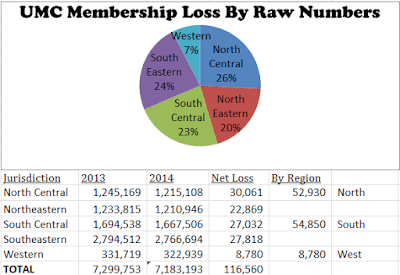I'll not address the content of the convocation in this post except to note that the presenters, Professors James and Molly Scott, offered excellent ideas and processes for a potential restoration, if one is to be done. Their book and CD can be found here.
However, despite my enthusiasm for their ideas, I am pessimistic that anything can be done to reverse the decades-long downward trend in the number of people belonging to the UMC in the United States. (The UMC is a worldwide denomination and is growing outside the US.) In 1968 there were almost 13 million UMs; now there are about 8 million. Of these, we were told, the average age is 60. They didn't say what the median age is, but I expect it's higher. However, for this post I'll assume that the median age and the average age are about the same. The median age for all Americans is 36.4 years (Census tables here).
What the convocation ignored was what the graying of the denomination portends. Once the mention was made of UMs' ages, the subject was dropped and we moved on to discussing how to fix the machinery of the denomination as a whole.
Most demographers say that Europe is in a demographic death spiral, that is, the birth rate has fallen so low that there literally is not enough time left for the declining populations to recover and begin to grow in number. I could not help but ponder whether United Methodism is in the same fix. The thrust of the convocation was that we UMs can reverse the decline if we return to Wesleyan basics. Now, I'm keen to return to Wesleyan basics and think we should do that anyway, but the idea that we can (much less will) evangelize faster than the Grim Reaper reduces our numbers is a proposition that I find highly dubious.
Consider some actuarial facts. If indeed the median age is about the same as the average age, 60, that means that of the 8 million UMs living today, one-fourth, or 2 million, will be dead within 20 years, and another million dead about eight years later. So in less than 30 years, we will lose from death alone three-eighths of our present membership, leaving us at 5 million.
That decline does not include the hemorrhage of our youth who, when graduating from high school, graduate from the church as well (an issue affecting all denominations). I don't have the
demographic breakdown for that age group as a percentage of the UM total, but the church admits that, relative to the general population, people under 35 are underrepresented.
So the decline due to death of our numbers will be amplified by dropouts, mostly, though not exclusively the under-35 cohort.
There is only a small chance, IMO, that the number of people electing to leaved the denomination can be matched by those joining. But the idea that new members can offset losses from both dropouts and death is simply not supportable. If we could do that (or were willing to do it), we would already be doing it. And the losses from death in the coming years will only accelerate.
It goes without saying that with an average age of 60, United Methodists are generally no longer bearing children. Of course there are families in our churches, but there is a very large number of UM churches that have no children. The fertility rate among European-descended, American women is lower than the 2.1 replacement rate. The overall American fertility rate of 2.08 is that high only because non-white women are having more than two children each (on average, of course).
This national trend is reflected in the UMC, so I think I stand on safe ground in saying that, on average, UM adults of childbearing age are not having enough children to replace themselves when they die, much less replace themselves and one or more older members. But no one I know of in the Methodist church's hierarchy or think tanks is addressing this part of the issue.
We might also consider that the median age of UM elders (who serve as senior pastors of churches) is 52, which is my own age. The average age is almost 51. Of the 17,000-plus elders in the denomination, only about 840 are 35 or younger. As a rule, older clergy will not attract younger members, especially families.
Furthermore, with a mandatory retirement age of 72, half of all elders will retire within 20 years (most clergy elect to retire before 70). So in addition to a shrinking membership, the UMC will be faced with a steadily graying clergy and an accelerating shortage to boot.
Update, 2016: "Coming to Terms with Numerical Decline in the U.S. UMC"
... the latest iteration of Vital Congregations data were released last month. They show growth in some faithful practices among American United Methodists, but declines in the production of new members. Combined with the death and other losses of existing members, this struggle with producing new members contributes to a pattern of numeric decline among American United Methodism that continues a decades-long trend in place since the formation of the denomination through merger in 1968.

No comments:
Post a Comment